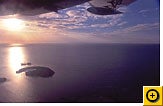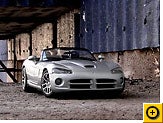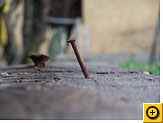 Take breathtaking photos from an aircraft window by minimizing camera shake, tweaking the focus and shutter speed, and more.
Take breathtaking photos from an aircraft window by minimizing camera shake, tweaking the focus and shutter speed, and more.
It seems that no matter where you go on vacation, there's some sort of airplane or helicopter tour available to let you get a better view. In fact, as you read these words, I plan to be on vacation, booking a sightseeing charter on a small plane somewhere. (I'll try to send you a postcard.)Even on an ordinary airplane, there are some cool sights to be seen from that tiny little window. The next time you find yourself on a plane, snap a few shots.
If you're getting ready for your summer vacation, remember to pack your digital camera--and remember these tips for getting some great shots from the passenger window.
Get published, get famous! Each week, we select our favorite reader-submitted photo based on creativity, originality, and technique. Every month, the best of the weekly winners gets a prize valued at between $15 and $50.
Here's how to enter: Send us your photograph in JPEG format, at a resolution no higher than 640 by 480 pixels. Entries at higher resolutions will be immediately disqualified. If necessary, use an image editing program to reduce the file size of your image before e-mailing it to us. Include the title of your photo along with a short description and how you photographed it. Don't forget to send your name, e-mail address, and postal address. Before entering, please read the full description of the contest rules and regulations.

This photo doesn't seem very remarkable--after all, it's just a picture of a car--until you learn that this is a die-cast model just a few inches long. The realism of the photo blows you away.
About this photo, Justin wrote: "I used my Kodak P850. In addition to photography, my hobbies include die cast collecting. The cars and trucks that I collect are 1:18 scale and are around 9 or 10 inches long. Since buying my first digital camera, I have been trying to photograph my die casts in a way that is realistic. The P850 allows me to get shots like this one. The model is a 2003 Dodge Viper SRT-10, made by a company called AUTOart, and I took it near an old feed mill. The key to making these miniature cars look real is to get a wide depth of field. I always use the F8 setting for the aperture, with no flash."

Jennean writes, "I took this picture in my backyard, on a piece of wood that surrounds my garden. I used a Kodak Easyshare C875, set on close-up mode."
See all the Hot Pic of the Week photos online.Plan Ahead If you're headed off for a sightseeing trip, let the flight crew know you have a camera and would like a seat that is close to one of the large windows. That's not always possible--in a helicopter, for example, they arrange passengers by weight--but it doesn't hurt to ask.
In addition, if you're on a sightseeing flight, ask the pilot before you take off if you can open any of the windows. Regulations sometimes prohibit open windows, but getting glass out of the way can dramatically improve your shots. And at the risk of being really annoying, if you're stuck shooting through glass, ask if you can clean the windows beforehand. I once was positioned next to a horribly dirty window, but I asked if it could be cleaned--and the ground crew wiped it down for me before we took off. I got some nice photos as a result.
So, there you are: 10,000 feet in the air and circling the Grand Canyon, Hoover Dam, a Hawaiian waterfall, or the Statue of Liberty.
It might seem like a good idea to steady the camera by leaning it against the aircraft itself or the window. However, the vibration from the engine will ruin your photos. Suspend the camera in front of you, and be careful to keep from transmitting vibrations from the wall and window to your camera.
Likewise, shoot at the highest shutter speed possible to counteract the natural motion of the aircraft. If your camera has a shutter priority or action photography mode, you can use that.
The more you zoom, the higher your shutter speed should be. For example, if you're taking a wide-angle, panoramic-style shot of the earth below you, a leisurely 1/30 or 1/60 second might be enough. But if you take advantage of your camera's 10X optical zoom to pick a squirrel out of a tree from a helicopter that's 5,000 feet in the air, you should be shooting at the fastest speed your camera can muster. To help your camera find a faster speed, try increasing the ISO a little.
At the distances you'll be shooting, there's no need to focus your camera; everything will be at "infinity." If your camera has a manual focus mode, use that mode and then set the focus on infinity.
The advantages? You don't have to wait while the camera fruitlessly searches for the right focus, and you don't risk the camera accidentally focusing on dirt on the aircraft window and ruining your shot.
If your camera doesn't have a manual focus control, then it almost certainly has a Landscape exposure mode (often one of the scene settings). One of the things that Landscape does is set your camera to focus at infinity, so that's a good substitute.
And by the way, before you head off on vacation, take a look at some of my other vacation photo tips from the past: "Take Better Travel Photos" and "More Travel Photo Tips."
http://www.ecoustics.com/pcw/howto/133648